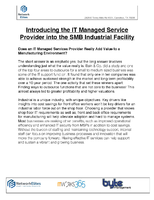NEMA establishes two programs to improve electrical grid.
Press Release Summary:
In decade since the 2003 blackout that crippled much of northeastern U.S. and Canada, NEMA has established two programs focused on improving the electrical grid. Emerging Technology Panel meets twice per year to discuss major challenges faced by utility and commercial customers to identify future directions that will be beneficial to the industry and consumers. In coordination with ETP, NEMA’s Strategic Initiatives program tackles technical and policy hurdles necessary to implement ETP’s vision.
Original Press Release:
Decade Passes Since 2003 Blackout, NEMA Establishes Two Programs to Improve Electrical Grid
ROSSLYN, Va., —Today marks the tenth anniversary of the 2003 blackout that crippled much of the northeastern United States and Canada.
“It’s appropriate that the White House released its report, Economic Benefits of Increasing Electric Grid Resilience to Weather Outages, this week,” says National Electrical Manufacturers Association (NEMA) President and CEO Evan R. Gaddis. “With a price tag that topped $60 billion in some estimates, it’s important that we re-examine the root causes and contributing factors of the 2003 blackout to ensure an event of that magnitude never happens again.”
In the decade since the blackout, NEMA has established two major programs that are focused on the technical and policy aspects of improving the performance of the electrical grid: the Emerging Technology Panel (ETP) and NEMA Strategic Initiatives (SI) program.
ETP is a group of 20 chief technologists and senior scientists from NEMA membership. Meeting twice a year, ETP discusses major challenges faced by their utility and commercial customers to identify future directions that will be beneficial to the industry and consumers.
In coordination with ETP, NEMA’s SI program tackles the technical and policy hurdles necessary to implement ETP’s vision. Smart Grid, high performance buildings, energy storage, industrial energy efficiency, microgrids, and nanotechnology are all examples of past strategic initiatives.
“Our top-level strategy is simple,” says Senior Vice President of Operations Ric Talley. “We examine the technical barriers to implementation, move to identify standardized solutions to overcome them, and then promote those standards to regulators and legislators.” Tally also notes that because NEMA is both a trade association and an ANSI-accredited standards developer, the association provides a natural forum to seek industry-wide solutions to problems.
“The tricky part of the equation is quantifying the benefits for those solutions to state and federal regulators,” Talley says. “We not only look to our members, but also rely heavily on industry partners like the Edison Electric Institute and the Smart Grid Interoperability Panel.”
NEMA is the association of electrical equipment and medical imaging manufacturers, founded in 1926 and headquartered in Arlington, Virginia. Its member companies manufacture a diverse set of products including power transmission and distribution equipment, lighting systems, factory automation and control systems, and medical diagnostic imaging systems. Total U.S. shipments for electroindustry products exceeds $100 billion annually.
NEMA. Setting Standards for Excellence
Visit our website at www.nema.org




